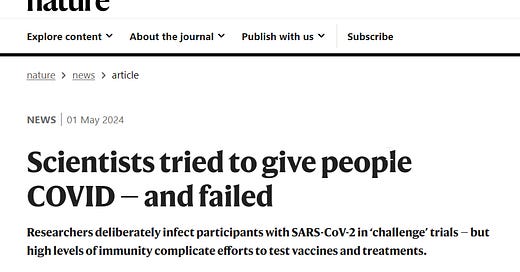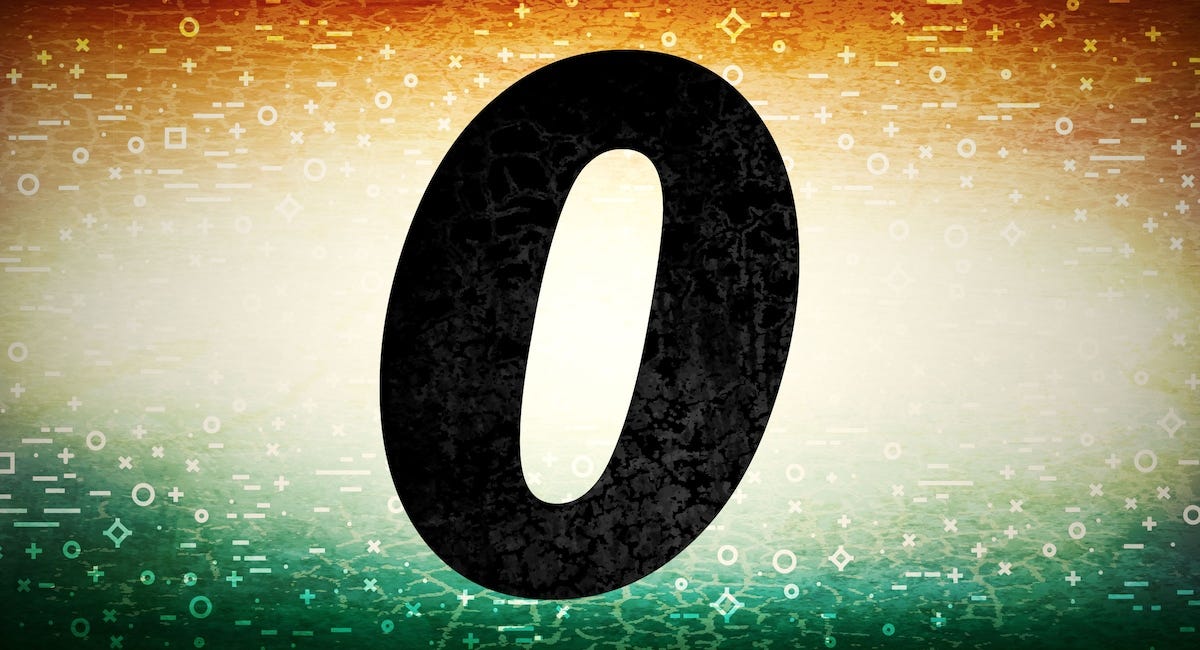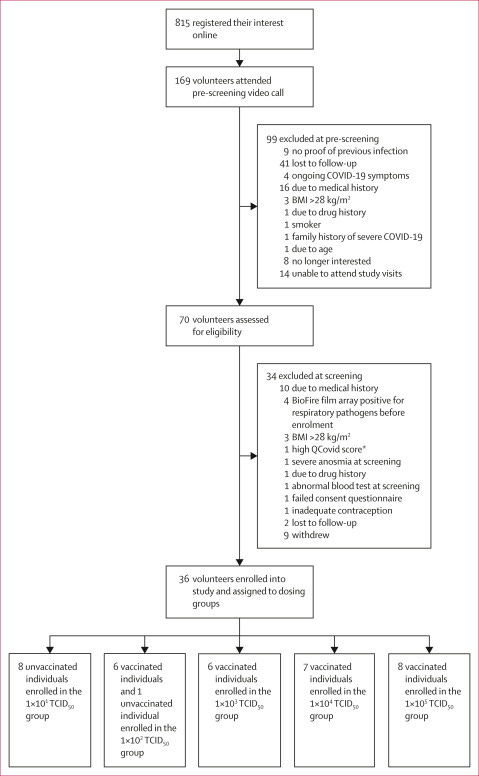Another virus challenge trial spectacularly fails...
...showing us how little we actually know.
A study has been published in the Lancet journal Microbe reporting on the spectacular failure of scientists to deliberately infect a group of volunteers with “covid”1.
Click in the picture below to go to a commentary in Nature about the study:
In the study, scientists tried to deliberately infect 36 previously infected2 people with “covid”.
They induced illness in - wait for it - zero.
Yep, nobody. Zilch.
Here is the methods section from the abstract:
And the results (an epic fail!):
The last part of the abstract above describes how 14 of the 36 volunteers “subsequently developed breakthrough infection with the omicron variant after discharge from quarantine”.
Rather than admitting the limitations of their knowledge and the utter fruitlessness of their endeavours, incredibly the authors interpret this thus:
The community breakthrough infections seen with the omicron variant supports the use of newer variants to establish a model with sufficient rate of infection for use in vaccine and therapeutic development.
Close analysis of the “community breakthrough infections”, including review of the supplementary materials, reveals some interesting data.
As can be seen from the study flowchart (see bottom row), 9 of the 36 subjects were “unvaccinated”
If you take a look at Supplementary Table 2 in the appendix it is clear that only one of the 9 unvaccinated subjects had a community acquired breakthrough infection in the follow-up period of 12 months, compared to 13 of the 27 subjects who had been vaccinated for covid.
This disparity was completely ignored by the authors3. They ought to have concluded that:
It’s very difficult to deliberately infect people with respiratory viruses regardless of vaccination and prior infection history.
However vaccination seems to make subjects more susceptible to infection in the community.
Instead, they claim that the lack of ability to infect subjects deliberately proves that the vaccines induce durable immunity (whereas per below this methodology was doomed anyway, and these subjects had all previously been infected anyway), totally ignoring the increased rate of subsequent illness in the vaccinated.
The Nature commentary said that this study cast doubt on the:
..usefulness of COVID-19 challenge trials for testing vaccines, drugs and other therapeutics. “If you can’t get people infected, then you can’t test those things,” says Tom Peacock, a virologist at Imperial College London.
Well, Tom Peocock, I would say that the more important messages are these:
Your theories of transmission of “covid” lie in tatters.
You and colleagues were foursquare behind the imposition of unprecedentedly harmful and dystopian policies based on unevidenced assumptions about disease transmission.
Yet all this was predicted from the known science - which you ignored.
You need to apologise to humanity and resign your cushy overpaid underworked position; such egregious and spectacular failure would ordinarily result in being “let go” in the private sector.
Of course, this wouldn’t be news to Milton Rosenau4, whose heroic attempts to transfer illness with “the flu” in 1918 (during the “Spanish Flu pandemic” were similarly spectacularly unsuccessful.
See here for further details of the series of human experiments conducted by the Public Health Service and the U.S. Navy under his supervision in Boston Harbor and San Francisco.
The experiment basically concluded that:
It seemed that what was acknowledged to be one of the most contagious of communicable diseases could not be transferred under experimental conditions.
Rosenau’s JAMA paper on the experiments can be found here.
Whilst on the topic of “it’s easier to list what we know rather than what we don’t know”, my attention was drawn this week to this piece in the Daily Mail:
Will Jones at The Daily Sceptic wrote this commentary on this story.
He stated that:
Until late 2020, the WHO had only considered a few infections as airborne, such as tuberculosis and measles. Most of them were classified as “droplet transmission”.
Covid was classified the same way at first. That messaging prompted millions of people in early 2020 to disinfect every surface, including groceries and mail. This even drove a shortage of cleaning supplies at the time.
But evidence grew that Covid could be transmitted via aerosolised particles. Suspended particles can remain in the air for hours, casting a pathogenic cloud over an infected person that follows him wherever he goes.
(The “Landmark WHO paper”5 can be found here.)
Of course, the redoubtable
6 has given a detailed account in her book Expired7 about the misunderstanding which has, for years, led to the faulty idea that respiratory viruses are spread by fomites (ie droplets) on surfaces, rather than by aerosolized particles which remain suspended over long period in the air8.The assumption of fomite spread formed the basis of justifying the ridiculous isolation and social distancing rules of lockdowns, which have left much of the world with PTSD, and a disabling anxiety about being in contact with “germs” which in some will likely be lifelong.
In my considered opinion, the main thing all the above shows us is:
We know didly squat9 about how respiratory illnesses are transmitted - if at all - between people.
I’m reluctantly adopting here the language of the authors and much of the population, but admit nothing in respect of the existence of a novel disease called “covid”.
Defined as prior “quantitative RT-PCR or lateral flow antigen test”, whatever those tests truly mean.
Fisher’s exact test on these data gives a p value of .06 - just short of statistically significant at the 5% level. But that is no excuse for not even mentioning this striking finding, which is the opposite of that desired from a “vaccine” for an infectious disease.
Professor of Preventive Medicine and Hygiene at Harvard Medical School.
LMAO
For the record, I have similar doubts to Mike Yeadon about the precise role that viruses play in respiratory illnesses, whether they - or anything at all - are responsible for transmission of such illnesses between people, and whether pandemics of these viruses can really occur.
Rather surprised to find that this is an idiom familiar to Americans, as I’d presumed - before looking it up - that it sounded peculiarly British!










Remember the flip from
- "you won't get Covid" >>
- "breakthroughs are very rare" >>
- "breakthroughs are very common - and great for super-immunity"
Yes, negative efficacy in a pharmaceutical product is actually a GOOD thing!
Then the psy-op went into over-drive when mass vaccine failure meant the 'pandemic' continued, and policies of mass-masking, mass-testing and two weeks mandatory 'isolation' of the 'fully-vaccinated' took hold - and a booster was widely mandated*.
The 'pandemic' that Australia avoided started AFTER the worse-than-useless vaccines.
*Plus anti-virals with negative efficacy were added into the mix. It's normal to catch Covid when taking Paxlovid, after all. It means it's working. You just need to take it for longer.
William of Ockham would probably have a thing or one to say about it too!